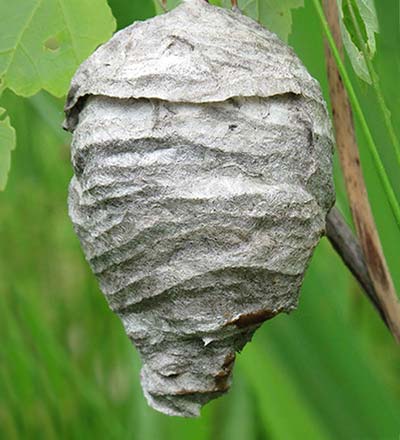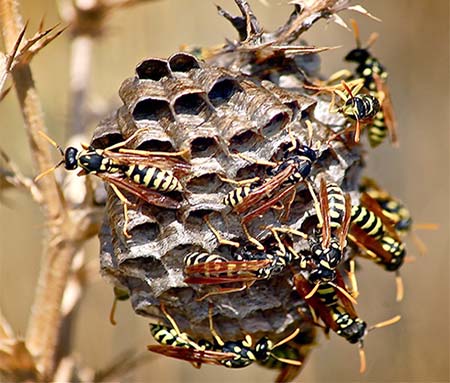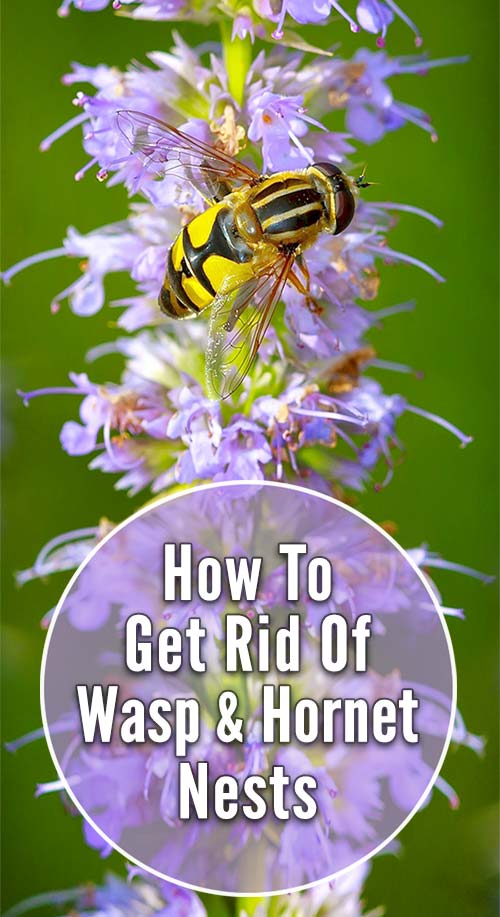Topics Covered
Wasps. The winged menace that take over patios and gardens all around the world. The evil cousin of the honey bee that fears no human.
Well, that’s their reputation, but an obvious exaggeration.
For the most part, wasps, hornets and yellow jackets generally try to avoid human interactions. Regardless, very few homeowners welcome the spring invasion of nests. It’s always preferable to ensure that these insects are kept away, especially if their nest is near a doorway or other area that increases your chances of crossing paths.
With this in mind, let’s discuss some methods that every homeowner should know to get rid of wasps, create an unwelcome environment, and, most importantly, help you avoid getting stung.
How to Keep Wasps Away From Your House
Like many other insects in your garden, wasps are going to go where they believe food is. So, if you want to limit the amount of wasps living near your home, then you need to attempt to limit their food source. This means ensuring that no food is left out in the open. Especially, sugar sweets and fruit.
During the summer, you may enjoy having a meal in your backyard. All that food can be rather enticing for wasps, yellow jackets and other insects. That is especially true if you have anything sweet in the vicinity such as an open can of soda or juice box. Always cover your drinks if you are outside.

Grow Plants That Wasps Don’t Like
A great way to prevent wasps from living around your home is to grow plants that will deter them. This is an ideal solution for homeowners that want to keep wasps at bay, while also adding beauty to their yard.
Generally, wasps do not go near the following plants:
- Citronella
- Mint
- Eucalyptus
- Wormwood
Incorporating these plants into your landscaping will help create an environment that wasps and hornets do not like. Therefore, they will likely look for another location to build their nest.
Bonus: A few of these plants also repel other pesky insects, such as mosquitoes.
Maintain Your Fruit Trees
Additionally, you want to be mindful if you have any fruit trees in your yard. Throughout the year, a piece of fruit may fall off and smash to the ground. With all the sweet juices now in the open, it can attract certain pests, including wasps.
Try not to make the area more appealing than it needs to be. Regularly inspect underneath your fruit trees and remove any pieces of fruit as soon as they hit the ground.
Create & Hang a Fake Nest
Wasp colonies are incredibly territorial. If wasps believe there is another colony already living in the area, then they are likely going to look elsewhere to make a home.

There are a couple of ways to accomplish this. The easiest method would be to buy a fake nest online. Or, you can make a fake nest with a brown paper bag.
How to make a fake wasp nest:
- Fill your brown paper bag with crumpled newspaper or debris.
- Close off the opening with sting or tape.
- Crumple the bag a little bit, to give it the appearance of a hornets nest.
- Hang it in the area where you don’t want wasps buzzing around.
This is a great way to deter wasps, as they will not want a confrontation with other colonies already living in the area.
Other Ways to Prevent Wasps From Living Near Your Home
While the food source is going to be the best method, there are a few other ways you can deter wasps and yellow jackets from living around your home.
-
Seal Cracks, Window Frames & Entry Points:
Before summer comes around, you should thoroughly inspect your house to see if there are any cracks or other entry points in the siding. You should also inspect door and window frames to make sure there are no areas for wasps to get into.
-
Sweet Perfume:
You also want to avoid wearing any sweet perfume during the summer. The scent you are emitting can attract the pests.
-
Bright Clothes:
Finally, avoid wearing clothing that contains flower imagery or is generally bright. That can catch wasps’ attention, and they may curiously come to you to see if you are actually a flower.
TL;DR — If you do not give wasps a reason to buzz around your property, then they are probably going to go elsewhere and leave you alone.
General Tips to Removing a Nest
If you decide you want to get rid of a wasp nest on your own, then it would be wise to understand and follow these general tips.

-
Wear Protective Equipment:
Keep yourself safe by wearing long sleeves, protective eyewear, and gloves. If you have a bee hat, that would be ideal. But, most homeowners will not have these.
-
Neutralize at Night:
To ensure you kill the entire colony, as well as the queen, it is recommended that you exterminate the nest at dusk or night. Not only are wasps and hornets less aggressive at this time, but the entire colony will be back in the nest for the night.
-
Locate & Target the Opening:
If possible, try to locate the opening of the nest. This will usually be located near the bottom. Spray your soapy water or pesticide in this area first, and then target the rest.
-
Do Not Stand Below the Nest:
Most wasps and hornets will fall the moment they get sprayed. Because of this, you should not stand directly below the nest, unless you want to be exposed to chemicals or get stung by falling wasps.
4 Methods to Kill & Remove Wasps
In the event that you notice wasps, hornets or yellow jackets buzzing around your home, then your already beyond prevention. You’ll need to find a way to remove them.
The easy way would be to simply spray them with pesticide. But, do you really want to spend money to spray a poisonous substance around your home? Instead, try using a few of these tips to help you get rid of wasps naturally.
1) Spray With Soapy Water
An easy, DIY alternative to spraying pesticide is to create a solution of dish soap and hot water. Spray this onto the nest. This is the recommended first step that every homeowner should try. This will kill the wasps naturally and, most of the time, instantaneously.
How to Make:
- Mix solution in a spray bottle.
- For every cup of hot water, you’ll want to add 2-3 oz of dish soap.
- Shake vigorously.
- Spray directly onto nest while the water is still hot.
- Run.
Stay mindful of your escape route. Once you apply the soapy water, it is likely that you will agitate the hornet nest and they may try to attack. You could also try mixing in other detergents that are around your home.
Benefits:
- Safe for all occupants and pets.
- Cheap and easy to make.
- Likely, you already have all supplies.

2) Suck Them Up With A Vacuum
Another easy way to remove wasps are to suck them into your vacuum cleaner. Most homeowners have a vacuum in their home, making this a zero cost way to remove adult insects.
Simply use the attachment hose, get close to the nest and turn it on. This will suck the adult wasps into the vacuum, containing them in an area where they pose no risk to you. Of course, this means you have to be brave enough to get close to the nest.
Benefits:
- Costs nothing.
Disadvantages:
- Need to get close to the nest, and are more likely to get stung.
- You still need to destroy the nest.
3) Set Up Traps
If you don’t want to go near a nest and risk getting stung, you should consider setting up a few traps. There are a variety of different traps that will work.
You will want to hang these traps in areas where you, your family and your guests are not going near.
These traps consist of sweet-smelling solutions so wasps and other pests go to it and end up getting stuck. You can purchase wasp nests or make your own if you want to make it a DIY project.
- Glue Trap — Widely available online and at many retailers, this type of trap is covered in sticky adhesive that makes it difficult, if not entirely impossible, for wasps to fly away after they’ve landed on it. While an effective method, this type of trap is often criticized due to its ability to trap other insects and the slow nature in which they die.
- Bait & Lure Trap — Another trap you can use is a bait and lure trap. There are many versions available, including a few you can make yourself, but they all essentially accomplish the same task: Use bait to lure a wasp into the trap, where they are unable to escape.
How to Make Your Own Wasp Trap
- Cut the top off of a plastic 2-liter bottle.
- Fill the bottom part with sugary water.
- Turn the top part upside down, with the bottle top pointing downward.
- This configuration makes it difficult for a wasp to fly out.
4) Spray Nest With Insecticide
If the above methods fail or you just prefer to start with a commercial insecticide, here are some general tips you should know before you buy.
-
Active Ingredient:
It’s important that you get an pyrethrin or pyrethroid insecticide. The EPA has tested and determined that these “do not pose risk concerns for children or adults.”
-
Look Closely at the Label:
The words on the label are important. If you’re trying to kill wasps or hornets, make sure to buy an insecticide that is specially formulated for these pests. These will typically have “WASP” prominently displayed.
-
Caution vs. Warning:
Another important factor are the “signal words” on the label. Insecticides labeled with “Caution” are going to pose less of a risk to humans than those labeled with “Warning.” Either way, they’re both toxic. With this in mind, you should always exercise caution and take measures to protect yourself while using any insecticide.
Final Thoughts
Keep in mind: Simply knocking down a nest is not a complete solution. The remaining wasps will build a new one.
These are a few of the tips to get rid of wasps around your home. However, despite your best efforts, the day may come when you get stung. Clean the site immediately when this occurs. You may need to apply some antihistamine if it begins to hurt. In the event you have an allergic reaction to a wasp sting, you need to seek medical attention immediately.

Sutton Turner says:
I never knew you could make a fake wasps nest and that that would deter wasps. My parents had to call pest control last summer because they had so many wasps around their home. I appreciate the tips on how to get rid of wasps.
M says:
Helpful article. Looking for information for an “in the ground” wasp nest
Jenna Hunter says:
I really like the list of plants that wasps don’t like such as mint, wormwood, eucalyptus, and citronella. My cousin just discovered a wasp nest near his home when he was walking with his dog. It would be really nice for him to get a professional to get rid of them for him.
Frank Parker says:
Unfortunately, the plant list is not accurate. I came here trying to find out how to stop wasps from decimating my mint crop. For the last several years they attack the tops of all my spearmint plants, leaving a ball of white spit looking like substance on them, ultimately killing the tops of the plants. I use lots of mint every day, so I am infuriated by this. If anyone else has been having this experience & has a solution, please help.
ryan says:
i want to try the vacuum method, at night. i’ll have to seal the crack they’re crawling in through. i keep finding a wasp near the front window so ik they’re getting in my home. eeek!
LYnn says:
I have a nest concealed above my kitchen cabinets. Wasps coming down between cabinets in an open space. Nest is not reachable. What should I do. Can’t see it or get to it. Fall coming soon in Canada. If I block entrance. Will they eventually die?
Bick says:
We have a large hornet nest inside the wall of our mountain home. It’s a 100 year old house that has an open slat in one of the window frames and some water damaged wood within the walls. After killing about 50-60 with a badminton racket from the outside, they were getting a little too agitated.
Next step was to spray foam into the crack. This forced them to find a new hole to the inside of the house. About 20 a day were dying in the house due to lack of water or food before the chewed through a section of the foam.
After this, the next step was to screw a small piece of plywood between the window and frame with a tiny hole into the crack. We bought a powder duster sprayer and Sevin dust. We’ve sprayed the dust in there 6 times over a two week period and they’re still coming out into the house. Not sure how they’re staying hydrated unless they’re eating the eggs laid in the next. I think I’ll try the soapy hot water trick mentioned above for the next step. Other places have said that the Sevin dust is effective, but that hasn’t been the case here.
Overall there’s about 200 that have met their fate to date but they haven’t succumbed yet.
Emma says:
We have wasps inside our outdoor AC unit. How do we safely get rid of them?
Thomas Clarence says:
I’m glad you helped me to understand that removing wasp nests at night time is a good idea because they are less aggressive. This morning, I got stung by a wasp because I was trying to knock down a nest with a broom above my garage. I think it would be best for me to hire a pest control agency to do this for me so that I don’t get stung again.